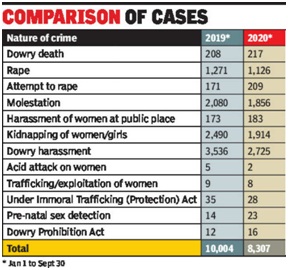

Context
The Supreme Court bench told petitioners seeking guidelines to discourage dowry in India that the matter was in the domain of the legislature.
Background
- In India, dowry persisted despite draconian criminal law provisions introduced in the Indian Penal Code, a new law in the form of the Dowry Prohibition Act of 1961 and the formation of the National Commission for Women.
- In the present day, dowry is paid in over eighty percent of marriages in Bangladesh, India, and Pakistan.
- The practice of dowry was proscribed in India in 1961. But even more than half a century after the ban, an Indian woman becomes a victim of dowry death roughly every one hour as per the National Crime Records Bureau(NCRB) 2019 data.
- As per NCRB-
- 10,366 cases were registered under ‘The Dowry Prohibition Act’ in 2020
- 6,966 cases of dowry deaths were reported in 2020.
- Highest number of cases was registered in Uttar Pradesh.
|
Marriage market in India
|
Analysis
What is dowry?
- Dowry, commonly known as ‘dahej’ is any gift that the groom’s side asks from bride’s side directly or indirectly.
- If any such demand is a precondition to marriage, then it is considered as dowry.
- This practice is common in cultures that are strongly patrilineal, patrilocal and have male-biased inheritance laws.
Causes of dowry system
- Social structure- The patriarchal nature of society which treat women as subordinate sex dependent on men for social and economic needs, thus dowry is seen as compensation for it.
- Tradition- As people believe they are adhering to social practice as a matter of choice than being forced to.
- Social security: Dowry is considered as a social security by girl’s parents to prevent any ill treatment to the bride.
- Lack of awareness: Less awareness among people about dowry related laws and regulations
Impact of dowry system
- On bride’s family-
- Financial burden that increases with the status of groom.
- Matter of prestige as more spending means higher position of bride’s family.
- Female infanticide and undernourishment.
- On bride-
- Objectification of women
- Considers herself as a liability on her family.
- Psychological burden and so, not able to call off marriage in case of marital issues.
- Dowry Death
|
Dowry death is defined as: “Where the death of a woman is caused by any burns or bodily injury or occurs otherwise than under normal circumstances within seven years of her marriage and it is shown that soon before her death she was subjected to cruelty or harassment by her husband or any relative of her husband for, or in connection with, any demand for dowry, such death shall be called “dowry death”, and such husband or relative shall be deemed to have caused her death”. |
- On society-
- Suicides, domestic violence and subordinate status of women.
- Indian society looked down by others due to such evil practices.
Challenges in ending dowry system
- Socio-Economic challenges-
- Subordinate status of women vis-à-vis men
- Social and Economic dependency of women on men.
- Peer pressure on bride’s family to spend higher to marry a better educated groom.
- Legal challenges-
- Delayed and denied justice
- Poor conviction rate
- Misuse of anti dowry laws by women
Ending dowry system and female empowerment-
- Dowry Prohibition Act 1980- Under it, any act to take or give dowry is punishable in India.
- Indian Penal Code- Crime non-bailable and can be booked under following sections-
- Section 304B- it is with regards to dowry deaths
- Section 498A- cruelty or domestic violence for dowry demands
|
Women Rights in India: Constitutional Rights and Legal Rights The rights entitled to women in India can be classified broadly into two categories namely constitutional rights and another one is legal rights but there is an exception in the case of fundamental rights.
The various constitutional and legal rights for women enshrined in India are summarized in the below table-
|
Reasons for Prevailing Women Issues in India:
- Prevailing Patriarchy: Indian Society has been a male-dominated society. This has lead to inferior treatment to women in the society in every front of life.
- Labelling women as a Liability
- Discrimination against Women: Many Indian women face discrimination throughout all stages of their life beginning at birth, continuing as an infant, child, adolescent, and adult.
- Economic factors
- Lack of education and leadership training
Concluding thoughts
Dowry is deeply prevalent in many communities in India and various other parts of the country. An immediate change cannot happen. The change has to happen at various levels if we are remove dowry completely.
While women are to be considered as goddess and worshipped, this should be practiced in reality and gender parity should be brought in the society by removing discriminatory practices like dowry.




